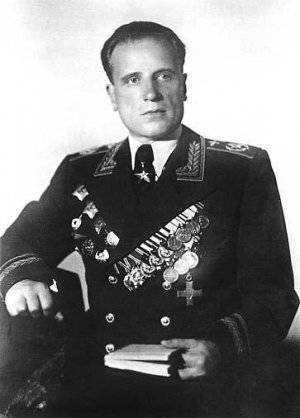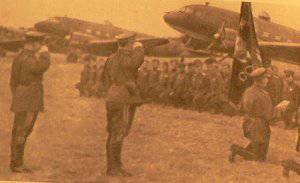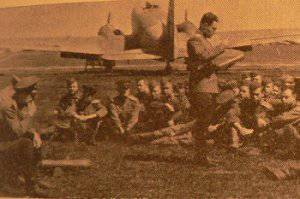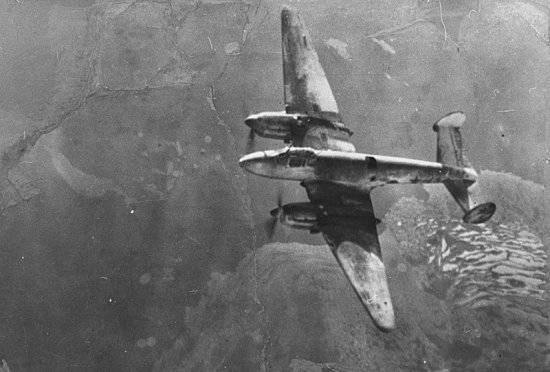Long-range aviation - ADD in war
Aviation long-range played a decisive role in the war.
212 st separate
 In January 1941, Golovanov, one of the country's best pilots, who became famous during the Finnish war and operation on Khalkhin Gol, wrote a letter to Stalin ...
In January 1941, Golovanov, one of the country's best pilots, who became famous during the Finnish war and operation on Khalkhin Gol, wrote a letter to Stalin ...In this letter, the pilot-ace proposed to create a large aviation compound that is capable of performing combat missions in the enemy’s deep rear in adverse weather conditions at any time of the day. He wrote: “It is this question, in essence, that will solve the success of the upcoming military operations in the sense of disorganizing the enemy’s deep rear lines, its industry, transport, ammunition, etc. etc., not to mention the possibility of landing operations. Having some experience and skills in these matters, I could take up the organization and organize the connection of planes in 100 – 150, which would meet the latest requirements imposed by aviation, and which would fly no worse than the British or Germans and would be the base for the Air Force frames and a further increase in the number of connections. "
Golovanova was stunned by the promptness with which the government reacted to his proposal. The very next day, the pilot was summoned to Stalin by the Kremlin, who was very attracted by Golovanov’s proposal. Soon it was decided to form a regiment of pilots who are well aware of the elements of a "blind" flight and familiar with the means of radar. In February 1941 of the year such a regiment was created - the 212-th separate long-range bomber. Golovanov was appointed his commander. The task was set before him: to ensure that the crews were able, day and night, in any weather, to deliver bombing strikes against the enemy’s deep rear. In the regiment, located near Smolensk, were collected the best pilots from all over the country, and began intensive training. Special attention was paid to studies in radio navigation and communications - long-range aviation had to be able to fly in the most difficult conditions and at the same time perform its tasks.
The regiment was often subjected to training anxieties, two to three times a week. Crews received combat missions and flew bombs. After the cancellation of the alarm, the exhausted pilots still had to go through the training program. People were tired of constant over-exertion, and at the regimental headquarters it was decided to arrange for them a day of rest next Sunday ...
On the night of Sunday called from the headquarters of the district. So Golovanov recalled this: “A phone call rang, I picked up the phone and heard from Minsk the excited voice of the duty officer in the okrug:
- Battle alarm, the Germans are bombing Lida!
Such calls in connection with training alarms were not uncommon at that time.
“Comrade duty officer,” I replied, “give at least one day the personnel to rest.” Just yesterday I raised the regiment according to my plan. Is it possible to postpone?
“The Germans are bombing Lida, I have no more time,” the attendant answered and turned off. ”
After that, the communication was interrupted, and the regiment stood for a long time in alertness, without instructions, complaining that the district headquarters were so poorly prepared for the exercises. Nobody knew that thousands of people were already dying right next to it ... Only in the second half of the day did the pilots find out about the beginning of the war - on ordinary radio, from Molotov's speech.
When the connection appeared, the regiment received an order to strike objects in the deep rear of the enemy. The pilots made one sortie after another, and without cover. Several crews were killed - by 28 June only 72 left from 14 aircraft, capable of performing combat missions. The rest were knocked down or required repair. But the pilots, carrying out their tasks on long-range bombing, managed to shoot down the 18 Messerschmidts.
 Golovanov in those crazy days of the outbreak of the sudden war showed sobriety of thinking and ability to navigate in emergency situations. Soon, Stalin appointed him commander of the 81st air division. Later, the 212nd separate long-range bomber regiment joined the division, which was considered the most experienced and skillful in aviation. The 81st air division successfully fought with the enemy, during the defense of Moscow inflicted tangible damage to it. In the bulletins of the Sovinformburo, they often talked about this division without naming its number: “As a result of the bombing and attack, one of our air units destroyed 14 on October 18-108 tanks, 189 vehicles with infantry and ammunition, 6 gas tanks, about 50 motorcycles, several guns and 2 anti-aircraft artillery batteries. ” “In one day, on October 24, 70 tanks, 220 vehicles with infantry and ammunition, up to 6 fuel tanks and 4 anti-aircraft fire points were destroyed in the area of Maloyaroslavets and Mozhaysk.”
Golovanov in those crazy days of the outbreak of the sudden war showed sobriety of thinking and ability to navigate in emergency situations. Soon, Stalin appointed him commander of the 81st air division. Later, the 212nd separate long-range bomber regiment joined the division, which was considered the most experienced and skillful in aviation. The 81st air division successfully fought with the enemy, during the defense of Moscow inflicted tangible damage to it. In the bulletins of the Sovinformburo, they often talked about this division without naming its number: “As a result of the bombing and attack, one of our air units destroyed 14 on October 18-108 tanks, 189 vehicles with infantry and ammunition, 6 gas tanks, about 50 motorcycles, several guns and 2 anti-aircraft artillery batteries. ” “In one day, on October 24, 70 tanks, 220 vehicles with infantry and ammunition, up to 6 fuel tanks and 4 anti-aircraft fire points were destroyed in the area of Maloyaroslavets and Mozhaysk.”With bombs on Berlin
At the beginning of 1942, it was decided at GHQ to create ADD - long-range aviation. Subordinate to ADD directly to Stalin. The commander was appointed Alexander Golovanov.
The headquarters transferred eight long-range bomber divisions and several airfields that had hard-surfaced runways to ADD. This expanded the combat capabilities and allowed the crews to fly smoothly at any time of the year.
The ADD delivered bombing strikes against the deep rear of the enemy, destroying the most important strategic objects. Moreover, the bombing of the territories occupied by the fascists, took place even when the USSR itself was under threat of seizure.
 Here is how English newspapers wrote about this in August 1942 of the year: “Russian air raids on Bulgaria, Romania and Hungary caused serious damage to numerous centers. Until now, it was generally believed that Russia was too far away and was busy defending its own front to attack the Balkans, and therefore many elements of precaution were missing there ... Special damage was inflicted on Budapest. According to one neutral diplomat, during the first raid on Budapest, the large railway station of the Hungarian capital suffered greatly and, according to the statement of the Hungarian press, the government requisition all glass in the city to repair windows. At present, all three states are frantically organizing air defense in the main cities and at the plants operating at the Nazis, prudently created in these countries, as if away from the bombers of the united countries ... "
Here is how English newspapers wrote about this in August 1942 of the year: “Russian air raids on Bulgaria, Romania and Hungary caused serious damage to numerous centers. Until now, it was generally believed that Russia was too far away and was busy defending its own front to attack the Balkans, and therefore many elements of precaution were missing there ... Special damage was inflicted on Budapest. According to one neutral diplomat, during the first raid on Budapest, the large railway station of the Hungarian capital suffered greatly and, according to the statement of the Hungarian press, the government requisition all glass in the city to repair windows. At present, all three states are frantically organizing air defense in the main cities and at the plants operating at the Nazis, prudently created in these countries, as if away from the bombers of the united countries ... "Even then, in the 1942 year, bombing of Berlin and other German cities was carried out. In addition to causing enormous damage to the enemy by bombing, ADD served another function. Long-range aviation carried out air support to the partisans. Ammunition, food, medicine for the partisans - all this was delivered to the deep rear of the enemy by the brave pilots of the ADD.
In addition, they carried out bombing "at the request" of the partisans. Golovanov cites such a curious document in his memoirs: “I request your order to help the partisan detachment and to bomb the German congregation of eight hundred people with equipment in settlements: p. Semenovskoe (eighteen kilometers north-west of Sevsk) and with. Alekshkovichi (twenty-three kilometers north-west of Sevsk), Suzemsky district of the Oryol region, after which the guerrillas will destroy the group. July 6, 1942, the Chief of the Central Headquarters of the Partisan Movement P. K. Ponomarenko.
And such “requests” were not at all uncommon - the ADD worked closely with the partisans. All major military operations were carried out with the direct participation of ADD. This is how official documents talked about it: “During the defensive battles on the Stalingrad sector from July 17 to November 19, 1942, ADD made 11 317 sorties, which accounted for 49 percent of all ADD combat sorties during this period. In November and December, despite the very poor meteorological conditions, ADD continued its combat activities in the Stalingrad sector, destroyed enemy troops and equipment, both in the areas of Stalingrad itself and at close approaches to it. ”
In total, during the existence of the ADD, according to military statistics, more than 194000 sorties were flown. Over the administrative and industrial centers of the enemy, more than 6600 sorties were made; railway junctions and highways - more than 65000; on enemy troops - more than 73000 sorties; on airfields - more than 18000 and on seaports - more than 6000 sorties. In addition, 7298 made flights to the enemy's rear on special missions and transported about 5500 tons of cargo, mainly ammunition, and about 12000 personnel. We can safely say that the victory of our army was brought on the wings of the ADD ...

Information